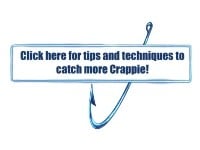The lakes and reservoirs in about half of those states provide strong ice fishing for these tasty panfish. That same line of distinction between frozen and unfrozen roughly describes the rule of shad. Almost all waters inhabited by crappies south of that line are dominated by shad as the primary forage fish. In those lakes and rivers, crappies tend to feed on shad year-round. Under frozen lakes, they often have to consider other options, and so should you when selecting lures or bait.
Spoon Or Jig?
When shad dominate a fishery, they become so prolific that crappies need to look no further for food, which really simplifies things for anglers. They know, even before launching a boat or pitching a float, crappies are feeding on minnows and that’s what they have to use or imitate with lures.
The same dynamic can occur way up north with other minnow species, but it becomes less common. Where dace, emerald shad, herring and other minnow species are prolific enough to persist in good numbers throughout the year, crappies continue to feed on them right through winter. On lakes like those, crappie minnows and small spoons work consistently well under the ice. Such lakes can be common even at the far northern extreme of the natural range of crappies (southern Canada).
Where good year classes of minnows are less consistent, crappies are forced to feed on insects and plankton when the ice arrives. When minnow forage thins out, using small spoons or minnows can become a fool’s errand. And, location can change as well.
Crappies feeding on minnows under the ice often utilize hard-bottom areas like humps, breaks and slopes. When forced to change over to an insect diet, crappies tend to be found on or near soft bottom flats or transitions between hard and soft bottom near the base of those other structures.
While it isn’t necessary to “match the hatch” exactly when crappies are feeding on mayfly nymphs or caddis larvae, they do tend to pay a lot less attention to spoons and minnows. They cue in on the easy meals that come on a regular basis, and may not be interested in one minnow when it seems like the next one could be a mile away. That’s when a baited jig, or one tipped with a tiny piece of plastic, will consistently out-produce a spoon.
Where crappies are predators 24-7, a spoon like the Rattl’n Flyer is the right choice. The smallest version is 1/16-ounce and a perfect crappie size. It can be tipped with the head or tail of a crappie minnow to create a scent trail, but -- unlike a lot of spoons -- the Flyer often works better without bait. A small Rattl’n Flyer on 4-pound monofilament “sails” off to the side on the drop, adding coverage area, and the rattle draws fish from a distance when the lure is snapped or popped.
A Ralt’N Flyer won’t spin, so it doesn’t require a swivel, but it flutters, sending flash in all directions. The bright color patterns help crappie locate the spoon in cloudy water, but it’s the rattle that draws them from any distance. Even on slow days when predatory crappies seem to prefer a live minnow on a plain hook, the Flyer will bring more of them in for a close look than any other spoon.
In clear water, crappies can demonstrate an aversion to rattles, and smart anglers are better served with a silent spoon. The 1/16-ounce Frostee is a favorite with crappie anglers because most prefer to bait spoons with minnow heads. The slow drop and twitching action of the flat-sided Frostee is accentuated by the addition of bait, and it’s offered in 16 different patterns for matching every possible water color when pressured crappies turn wary and tough to turn.
When crappies become grazers, you’re better off with a small jig tipped with a waxworm, several maggots or one of the great new panfish plastics on the market today. The Lindy Ice Jig is a compact “big eye” jig that drops fast but shows a small profile, and comes with five little 1-inch plastic tails, each with a different shape for imitating various larval insect and minnows. Crappies love these things. The tails keep quivering long after you stop applying energy.
When crappies demonstrate a need for livebait, slip a few maggots onto a Lindy Micro Slick Jig, Toad or Lindy Bug. All of these jigs have intriguing balance, allowing them to teeter, dance and bobble in ways other jigs can’t -- giving pressured crappies in tough lakes something new and different to look at.
Crappies feeding on insect larvae should be approached with 2-pound mono, light jigs, and thin, sensitive rods. A spring bobber helps. Crappies aren’t accustomed to seeing larvae run away, so they can be very casual about taking a jig. In clear water they often spook unless subtle jigs are lowered very slowly for the last few feet. When the sonar shows no fish, make two or three aggressive jigging strokes to attract, then let the jig rest, tapping the blank occasionally to quiver a plastic tail or a pair of trailing maggots.
Some lakes run low on minnow forage by early winter, so use plastics or maggots on your jigs to tempt big crappies. Approach the rest with spoons and minnows. Those are the primary hardwater rules for crappies.




 Articles and Stories
Articles and Stories

















vBulletin Message